Primary Key vs. Unique Index in SQLite: Performance, Semantics, and Best Practices
Understanding the Role of Primary Keys and Unique Indexes in SQLite
In SQLite, the distinction between a Primary Key (PK) and a Unique Index is often a source of confusion, especially for developers transitioning from other database systems like Oracle or MySQL. While both constructs enforce uniqueness, their underlying mechanisms, performance implications, and semantic meanings differ significantly. This post delves into the technical nuances of Primary Keys and Unique Indexes in SQLite, exploring their behaviors, use cases, and the trade-offs involved in choosing one over the other.
At the core of this discussion is the question: Why use a Primary Key when a Unique Index can enforce the same uniqueness constraint? The answer lies in the deeper integration of Primary Keys with SQLite’s storage engine, their role in optimizing query performance, and their semantic importance in defining table relationships. Additionally, the WITHOUT ROWID optimization introduces further complexity, as it fundamentally changes how Primary Keys are stored and accessed.
This post is structured into three main sections:
- Primary Keys and Unique Indexes: Behavioral and Technical Differences
- Performance Implications of Primary Keys vs. Unique Indexes
- Best Practices for Choosing Between Primary Keys and Unique Indexes
Each section provides a detailed analysis of the topic, supported by examples and insights into SQLite’s internal mechanisms. By the end of this post, you will have a comprehensive understanding of when and why to use Primary Keys or Unique Indexes in your SQLite database designs.
Primary Keys and Unique Indexes: Behavioral and Technical Differences
The Nature of Primary Keys in SQLite
In SQLite, a Primary Key is more than just a uniqueness constraint. It is a fundamental part of the table’s structure, deeply integrated into the storage engine. When you define a Primary Key, SQLite creates an implicit index on the specified column(s), but this index is not just any index—it is tightly coupled with the table’s row storage mechanism.
For tables that use the default ROWID mechanism, the Primary Key (if it is a single column of type INTEGER) becomes an alias for the ROWID. This means that the Primary Key column directly maps to the internal row identifier, eliminating the need for a separate index. This integration provides significant performance benefits, as accessing a row via its Primary Key is essentially a direct lookup in the table’s B-tree structure.
However, this behavior changes when dealing with non-INTEGER Primary Keys or composite Primary Keys. In such cases, SQLite creates a separate index to enforce uniqueness, but this index is still treated differently from a manually created Unique Index. For example, Primary Keys cannot contain NULL values, whereas Unique Indexes can (unless explicitly constrained).
Unique Indexes: Flexibility and Limitations
A Unique Index, on the other hand, is a standalone construct that enforces uniqueness on one or more columns. Unlike a Primary Key, a Unique Index does not have any special relationship with the table’s storage structure. It is simply an additional index that ensures no two rows have the same values in the indexed columns.
One key difference is that Unique Indexes can accommodate NULL values, allowing multiple rows to have NULL in the indexed columns. This flexibility can be useful in certain scenarios, but it also introduces ambiguity when enforcing uniqueness. Additionally, Unique Indexes do not provide the same semantic clarity as Primary Keys. While a Primary Key explicitly identifies the canonical identifier for a table, a Unique Index is merely a constraint.
The WITHOUT ROWID Optimization
SQLite’s WITHOUT ROWID tables introduce a significant twist to the Primary Key vs. Unique Index debate. When a table is created with the WITHOUT ROWID clause, the Primary Key becomes the actual storage key for the table. This means that the table’s rows are stored in the order of the Primary Key, and no separate ROWID is maintained. This optimization can lead to storage and performance benefits, especially for tables with large Primary Keys or complex composite keys.
However, WITHOUT ROWID tables come with stricter requirements. The Primary Key must be explicitly defined, and it cannot contain NULL values. This makes WITHOUT ROWID tables less flexible than regular tables but more efficient for specific use cases.
Foreign Key Constraints and Referential Integrity
Another important consideration is the role of Primary Keys in foreign key relationships. When a child table references a parent table, SQLite assumes that the reference is to the Primary Key of the parent table unless otherwise specified. This simplifies the syntax and improves readability, as you do not need to repeat the column names in the REFERENCES clause.
For example, consider the following schema:
CREATE TABLE parent (
id INTEGER PRIMARY KEY,
name TEXT
);
CREATE TABLE child (
id INTEGER PRIMARY KEY,
parent_id INTEGER REFERENCES parent
);
In this case, the parent_id column in the child table automatically references the id column in the parent table because id is the Primary Key. If the parent table used a Unique Index instead of a Primary Key, you would need to explicitly specify the referenced column:
CREATE TABLE parent (
id INTEGER UNIQUE,
name TEXT
);
CREATE TABLE child (
id INTEGER PRIMARY KEY,
parent_id INTEGER REFERENCES parent(id)
);
This additional verbosity can make the schema harder to read and maintain.
Performance Implications of Primary Keys vs. Unique Indexes
Insert Performance and Index Maintenance
One of the most significant performance considerations when choosing between a Primary Key and a Unique Index is the impact on insert operations. When a table has a Primary Key, SQLite must maintain the implicit index associated with the key. This can slow down bulk insert operations, as each insert requires updating the index.
For example, consider the following scenario:
CREATE TABLE test1 (
name TEXT PRIMARY KEY,
value TEXT
);
CREATE TABLE new_test (
name TEXT PRIMARY KEY,
value BLOB
);
INSERT INTO new_test SELECT * FROM test1;
In this case, the INSERT operation must maintain the Primary Key index for the new_test table, which can be time-consuming for large datasets.
In contrast, if you use a Unique Index instead of a Primary Key, you can defer the creation of the index until after the data has been inserted:
CREATE TABLE test1 (
name TEXT PRIMARY KEY,
value TEXT
);
CREATE TABLE new_test (
name TEXT,
value BLOB
);
INSERT INTO new_test SELECT * FROM test1;
CREATE UNIQUE INDEX u_name_new_test ON new_test(name);
This approach can significantly speed up bulk insert operations, as the index is built in a single pass after the data has been loaded.
Query Performance and Access Patterns
While Unique Indexes can improve insert performance, they may not provide the same query performance benefits as Primary Keys. As mentioned earlier, Primary Keys are deeply integrated with SQLite’s storage engine, allowing for direct row access via the key. This can lead to faster query performance, especially for point queries that look up a single row by its Primary Key.
For example, consider the following query:
SELECT * FROM test1 WHERE name = 'example';
If name is the Primary Key, SQLite can directly locate the row using the table’s B-tree structure. If name is instead indexed by a Unique Index, SQLite must first locate the index entry and then use it to find the corresponding row in the table. This extra step can introduce additional overhead, especially for large tables.
The Impact of WITHOUT ROWID on Performance
The WITHOUT ROWID optimization can further enhance the performance of Primary Keys by eliminating the need for a separate ROWID and storing rows directly in the order of the Primary Key. This can lead to more efficient storage and faster access patterns, particularly for tables with large or complex Primary Keys.
For example, consider the following schema:
CREATE TABLE new_test (
name TEXT PRIMARY KEY,
value BLOB
) WITHOUT ROWID;
In this case, the name column serves as both the Primary Key and the storage key, allowing SQLite to optimize both storage and access. However, this optimization comes at the cost of reduced flexibility, as WITHOUT ROWID tables cannot contain NULL values in their Primary Key.
Best Practices for Choosing Between Primary Keys and Unique Indexes
When to Use a Primary Key
- Canonical Identifiers: Use a Primary Key when a column (or set of columns) serves as the canonical identifier for a table. This provides semantic clarity and ensures that the table has a well-defined unique identifier.
- Foreign Key Relationships: Use a Primary Key when the table is referenced by foreign keys, as this simplifies the syntax and improves readability.
- Query Performance: Use a Primary Key for columns that are frequently used in point queries, as this allows for direct row access and can improve query performance.
WITHOUT ROWIDOptimization: Consider using a Primary Key with theWITHOUT ROWIDclause for tables with large or complex keys, as this can optimize storage and access patterns.
When to Use a Unique Index
- Deferred Indexing: Use a Unique Index when you need to defer index creation to improve bulk insert performance. This is particularly useful for large datasets or data migration scenarios.
- Nullable Columns: Use a Unique Index for columns that need to accommodate
NULLvalues, as Primary Keys cannot containNULLs. - Secondary Uniqueness Constraints: Use a Unique Index to enforce additional uniqueness constraints beyond the Primary Key. This is useful for columns that must be unique but are not the canonical identifier for the table.
Balancing Performance and Semantics
Ultimately, the choice between a Primary Key and a Unique Index involves balancing performance considerations with semantic clarity. While Unique Indexes can offer performance benefits in certain scenarios, Primary Keys provide a clearer and more integrated way to define a table’s identity and relationships. By understanding the technical differences and performance implications, you can make informed decisions that optimize both the functionality and efficiency of your SQLite databases.
In conclusion, the decision to use a Primary Key or a Unique Index in SQLite depends on a variety of factors, including the table’s role in the database, the access patterns, and the need for performance optimizations. By carefully considering these factors and applying the best practices outlined in this post, you can design SQLite schemas that are both efficient and semantically clear.






